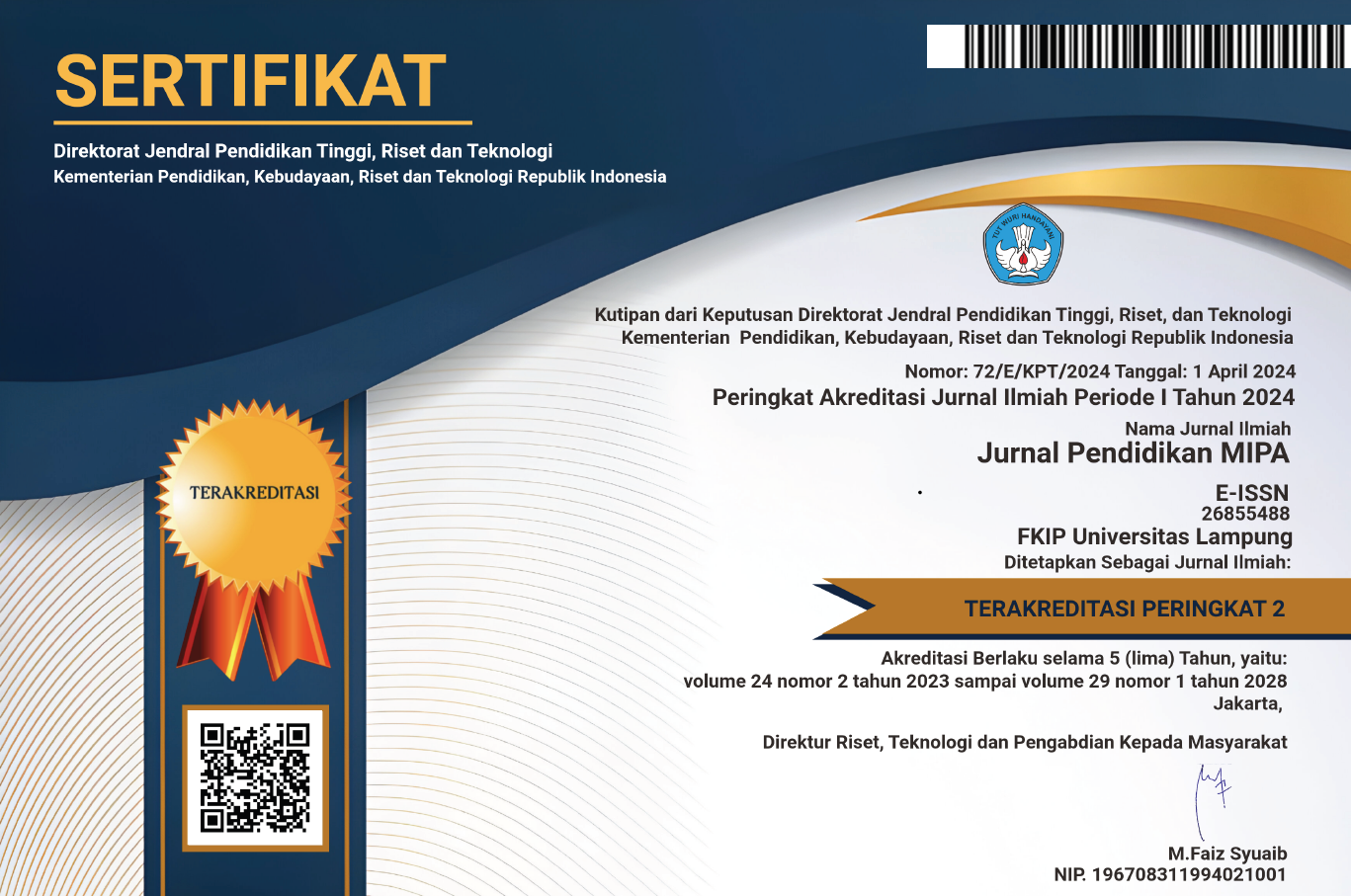Direct Current Electric Circuit-Visualization Skills Instrument Test (DCEC-ViSIT) to Measure High School Student’s Visualization Skills
 Country:
Country:
(1) Universitas Pendidikan Indonesia, Indonesia
(2) Universitas Pendidikan Indonesia, Indonesia
(3) Universitas Pendidikan Indonesia, Indonesia
This research aims to develop instrument test visualization skills on direct current electric circuits. The research method used is the development of a 4D model consisting of defining, designing, developing, and disseminating. The participants in this research consisted of 33 high school students in West Java who were randomly selected. The first analysis is an analysis of the results of expert validation using CVR, which is considered valid. The second analysis is the Rasch analysis, which obtained raw variance data with special interpretation and declared the questions valid. The third stage is the analysis of the parameters of the items included in the interpretation of "very appropriate" and "appropriate". The fourth stage of the reliability analysis used Rasch analysis, which showed that overall visualization skills items were reliable with a Cronbach Alpha of 0.71. But the consistency of the answers from the respondents is weak. Students' visualization skills need to be improved through models, methods, and visual media that support visualization skills.
Keywords: visualization skills, direct current electrical circuits, 4D model, Rasch analysis.
DOI: http://dx.doi.org/10.23960/jpmipa/v24i1.pp84-97
Bajpai, M., & Kumar, A. (2015). Effect of virtual laboratory on students’ conceptual achievement in physics. International Journal of Current Research, 7(02). http://www.journalcra.com
Contero, M., Company, P., Saorin, J. L., & Naya, F. (2006). Learning support tools for developing spatial abilities in engineering design. International Journal Engineering, 22(3). https://www.researchgate.net/publication/240921219
Hershkowitz, R. (1989). Visualization in geometry: two sides of the coin. Focus on Learning Problems in Mathematics, 11(1).
Hidayati, F., Tirtawirya, D., Yudhistira, D., Ode, L., Virama, A., & Naviri, S. (2022). Conditioning training program to improve the strength and endurance of football extracurricular participants: content validity and reliability. Asian Exercise and Sport Science Journal, 6(1). https://doi.org/10.30472/aesj.v6i1.288
Katsioloudis, P., Jovanovic, V., & Jones, M. (2014). A Comparative analysis of spatial visualization ability and drafting models for industrial and technology education students. Journal of Technology Education, 26(1), 88–101. https://doi.org/10.21061/jte.v26i1.a.6 96
Lestari, A. S., & Samsudin, A. (2020). Using rasch model analysis to analyze students’ scientific literacy on heat and temperature. Proceedings of the 7th Mathematics, Science, and Computer Science Education International Seminar, MSCEIS 2019. https://doi.org/10.4108/eai.12-10-2019.2296483
Mnguni. (2007). Development of a taxonomy for visual literacy in the molecular life sciences. University of KwaZulu-Natal.
Mnguni, L. (2019). The development of an instrument to assess visuo-semiotic reasoning in biology. Eurasian Journal of Educational Research, 2019(82), 121–136. https://doi.org/10.14689/ejer.2019.82.7
Mnguni, L. E. (2014). The theoretical cognitive process of visualization for science education. In SpringerPlus (Vol. 3, Issue 1, pp. 1–9). SpringerOpen. https://doi.org/10.1186/2193-1801-3-184
Mnguni, L., & Moyo, D. (2021). An assessment of the impact of an animation on biology students’ visualization skills related to basic concepts of mitosis. Eurasia Journal of Mathematics, Science and Technology Education, 17(8), 1–11. https://doi.org/10.29333/EJMSTE/11116
Mnguni, L., Schönborn, K., & Anderson, T. (2016). Assessment of visualisation skills in biochemistry: Students. South African Journal of Science, 112(9–10). https://doi.org/10.17159/sajs.2016/20150412
Muslihin, H. Y., Suryana, D., Ahman, Suherman, U., & Dahlan, T. H. (2022). Analysis of the reliability and validity of the self-determination questionnaire using rasch model. International Journal of Instruction, 15(2), 207–222. https://doi.org/10.29333/iji.2022.15212a
Nurdini, N., Suhandi, A., Ramalis, T., & Samsudin, A. (2020). Developing multitier instrument of fluids concepts (mifo) to measure student’s conception: a rasch analysis approach learning models for students’ conceptual change view project learning progression and conceptual change pre-service elementary teachers’ with cognitive conflict view project. Article in Journal of Advanced Research in Dynamical and Control Systems. https://doi.org/10.5373/JARDCS/V12I6/S20201273
Omar, M., Ali, D. F., Mokhtar, M., Zaid, N. M., Jambari, H., & Ibrahim, N. H. (2019). Effects of mobile augmented reality (MAR) towards students’ visualization skills when learning orthographic projection. International Journal of Emerging Technologies in Learning, 14(20), 106–119. https://doi.org/10.3991/ijet.v14i20.11463
Özkan, A., Arikan, E. E., & Özkan, E. M. (2018). A study on the visualization skills of 6th Grade Students. Universal Journal of Educational Research, 6(2), 354–359. https://doi.org/10.13189/ujer.2018.060219
Rusmana, N., Suryana, D., Kurniasih, H. S., & Almigo, N. (2020). The development of speaking Skill’s instrument in elementary school with rasch model analysis. Universal Journal of Educational Research, 8(7), 2758–2765. https://doi.org/10.13189/ujer.2020.080702
Sarwono. (2021). Visual multimedia supported computer based refutation text untuk pengajaran remedial berorientasi remediasi miskonsepsi siswa sma terkait konsep-konsep pada materi rangkaian listrik arus searah. Universitas Pendidikan Indonesia.
Semenikhina, O., Yurchenko, A., Udovychenko, O., Petruk, V., Borozenets, N., & Nekyslykh, K. (2021). Formation of skills to visualize of future physics teacher: results of the pedagogical experiment. Revista Romaneasca Pentru Educatie Multidimensionala, 13(2), 476–497. https://doi.org/10.18662/rrem/13.2/432
Sumintono, B. (2018). Rasch model measurements as tools in assessment for learning. 1st International Conference on Education Innovation, 173.
Sumintono, B., & Widhiarso, W. (2015). Aplikasi pemodelan rasch pada assessment pendidikan (I). Trim Komunikata Publishing House.
Wati, M., Mahtari, S., Hartini, S., & Amalia, H. (2019). A Rasch model analysis on junior high school students’ scientific reasoning ability. International Journal of Interactive Mobile Technologies, 13(7), 141–149. https://doi.org/10.3991/ijim.v13i07.10760
Wibowo, F. C., Suhandi, A., Samsudin, A., Rahmi DARMAN, D., Suherli, Z., Hasani, A., Mukti LEKSONO, S., Hendrayana, A., Hidayat, S., Hamdani, D., & Coştu, B. (2017). Virtual Microscopic Simulation (VMS) to promote students’ conceptual change: A case study of heat. In Asia-Pacific Forum on Science Learning and Teaching (Vol. 18, Issue 2).
Wilson, F. R., Pan, W., & Schumsky, D. A. (2012). Recalculation of the critical values for Lawshe’s content validity ratio. Measurement and Evaluation in Counseling and Development, 45(3), 197–210. https://doi.org/10.1177/0748175612440286
Yudhistira, D., & Tomoliyus. (2020). Content validity of agility test in karate kumite category. International Journal of Human Movement and Sports Sciences, 8(5), 211–216. https://doi.org/10.13189/saj.2020.080508
Refbacks
- There are currently no refbacks.

This work is licensed under a Creative Commons Attribution-ShareAlike 4.0 International License.






